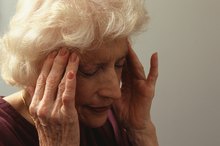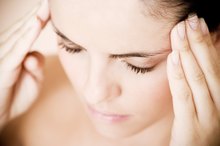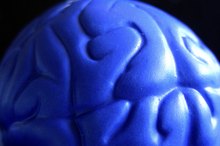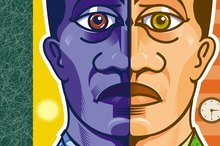Signs of a Stroke While Sleeping
**A stroke is defined as the sudden onset of neurological symptoms that result from a disruption in the flow of blood to part of the brain [2](# 'inline-reference::"Harrison’s Principles of Internal Medicie, 16th ed.
If you are experiencing serious medical symptoms, seek emergency treatment immediately.
**"; Dennis L. Kasper, et al. (eds. ); 2005'). If a stroke occurs while sleeping, the presence of symptoms after awakening would constitute the signs of a stroke. In this context, it is important to distinguish between a stroke and a transient ischemic attack, or TIA, which some people call a "mini-stroke."
Movement Problems
Problems with movement or coordination can indicate a stroke [1](# 'inline-reference::"Clinical Neurology, 7th ed. "; Rodger P. Simon, et. al.
(eds); 2009')2. A sudden weakness or paralysis, particularly when it involves all or part of one side of the body, is an example of such a problem 2. Strokes often affect the sections of the brain that control movement of the face and tongue, so difficulties with facial expressions, chewing, swallowing or moving the tongue all may indicate that a stroke has occurred. Coordination is another aspect of movement that can be affected by a stroke 2. Disturbances in gait or balance, dizziness and difficulty performing familiar tasks that require coordination also are consistent with stroke.
- Problems with movement or coordination can indicate a stroke [1](# 'inline-reference::"Clinical Neurology, 7th ed.
- ";
Sensory Problems
Smell & Signs of a Stroke
Learn More
Sensation is another brain function that can be disrupted by a stroke.
Sudden complete or partial loss of vision, blurred vision, double vision and difficulties with eye movements all are symptoms of sensory disruption.
Problems with hearing or the sense of smell also are possible with a stroke 2. In addition, numbness to pain, touch or temperature, particularly when they affect all or part of one side of the face or body, are signs that a stroke may have occurred.
- Sensation is another brain function that can be disrupted by a stroke.
- In addition, numbness to pain, touch or temperature, particularly when they affect all or part of one side of the face or body, are signs that a stroke may have occurred.
Problems With Thinking or Cognition
**The areas of the brain that control thinking and higher cognition also may be affected by a stroke [2](# 'inline-reference::"Harrison’s Principles of Internal Medicie, 16th ed.
**"; Dennis L. Kasper, et al. (eds. ); 2005'). Loss of consciousness, confusion, sudden loss of memory and difficulties speaking, understanding speech, writing or reading may be symptoms of a stroke. Sudden severe headache, particularly when accompanied with loss of consciousness or nausea and vomiting, can be a sign that a particularly severe type of stroke may have occurred, although it is unlikely that someone would remain asleep despite these symptoms.
- The areas of the brain that control thinking and higher cognition also may be affected by a stroke [2](# 'inline-reference::"Harrison’s Principles of Internal Medicie, 16th ed.
- ";
Transient Ischemic Attacks
The Medical Conditions That Cause Weakness on the Left Side of the Body
Learn More
Like a stroke, a TIA is caused by a disruption of the flow of blood to part of the brain 1. In a TIA, however, the blood flow returns more or less to normal after a few minutes [1](# 'inline-reference::"Clinical Neurology, 7th ed.
"; Rodger P. Simon, et. al. (eds); 2009'). Neurological symptoms occur while the blood flow is diminished, but no areas of the brain are significantly damaged, and the symptoms eventually disappear. The neurological symptoms from a TIA typically last five to 15 minutes, but a stroke proper is not considered to have occurred unless they last longer than 24 hours 2. Depending upon the nature of the symptoms, a TIA that occurs while sleeping might not necessarily cause the individual to wake up. Since the symptoms are likely to disappear by the time the person wakes up, a TIA that occurs during sleep might not have any signs at all. TIAs are highly likely to reoccur, however.
- Like a stroke, a TIA is caused by a disruption of the flow of blood to part of the brain 1.
- The neurological symptoms from a TIA typically last five to 15 minutes, but a stroke proper is not considered to have occurred unless they last longer than 24 hours 2.
Related Articles
References
- "Clinical Neurology, 7th ed."; Rodger P. Simon, et. al. (eds); 2009
- "Harrison’s Principles of Internal Medicie, 16th ed."; Dennis L. Kasper, et al. (eds.); 2005
- Centers for Disease Control and Prevention. Stroke Signs and Symptoms. Updated March 27, 2018.
- Wei CC, Huang SW, Hsu SL, Chen HC, Chen JS, Liang H. Analysis of using the tongue deviation angle as a warning sign of a stroke. Biomed Eng Online. 2012;11:53. doi:10.1186/1475-925X-11-53
- National Institute on Aging. Stroke. Updated May 16, 2017.
- Eissa A, Krass I, Levi C, Sturm J, Ibrahim R, Bajorek B. Understanding the reasons behind the low utilisation of thrombolysis in stroke. Australas Med J. 2013;6(3):152-67. doi:10.4066/AMJ.2013.1607
- Goodwin D. Homonymous hemianopia: challenges and solutions. Clin Ophthalmol. 2014;8:1919-27. doi:10.2147/OPTH.S59452
- National Institute on Deafness and Other Communication Disorders. Aphasia. Updated March 6, 2017.
- National Institute of Neurological Disorders and Stroke. Stroke Information Page. Updated March 27, 2019.
- National Heart, Lung, and Blood Institute. Stroke. Updated August 14, 2018.
- Yanagawa Y, Yoshihara T, Kato H, Iba T, Tanaka H. Significance of urinary incontinence, age, and consciousness level on arrival among patients with stroke. J Emerg Trauma Shock. 2013;6(2):83-6. doi:10.4103/0974-2700.110750
- National Institute of Neurological Disorders and Stroke. Stroke: Hope Through Research. Updated August 13, 2019.
- Rowe FJ. Vision In Stroke cohort: Profile overview of visual impairment. Brain Behav. 2017;7(11):e00771. doi:10.1002/brb3.771
- Genetic and Rare Diseases Information Center. Wallenberg syndrome. 2017.
- Konczak J, Pierscianek D, Hirsiger S, et al. Recovery of upper limb function after cerebellar stroke: lesion symptom mapping and arm kinematics. Stroke. 2010;41(10):2191-200. doi:10.1161/STROKEAHA.110.583641
- Al-Qazzaz NK, Ali SH, Ahmad SA, Islam S, Mohamad K. Cognitive impairment and memory dysfunction after a stroke diagnosis: a post-stroke memory assessment. Neuropsychiatr Dis Treat. 2014;10:1677-91. doi:10.2147/NDT.S67184
- American Stroke Association. About Stroke.
- Kernan WN, Ovbiagele B, Black HR, et al. Guidelines for the prevention of stroke in patients with stroke and transient ischemic attack: a guideline for healthcare professionals from the American Heart Association/American Stroke Association. Stroke. 2014;45(7):2160-236. doi:10.1161/STR.0000000000000024
- National Institutes of Health. NIH Stroke Scale International.
Writer Bio
Sydney Hornby specializes in metabolic disease and reproductive endocrinology. He is a graduate of Claremont McKenna College and Drexel University College of Medicine in Philadelphia, where he earned his M.D., and has worked for several years in academic medical research. Writing for publication since 1995, Hornby has had articles featured in "Medical Care," "Preventive Medicine" and "Medical Decision Making."









